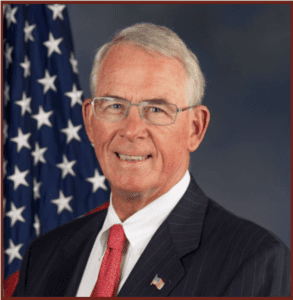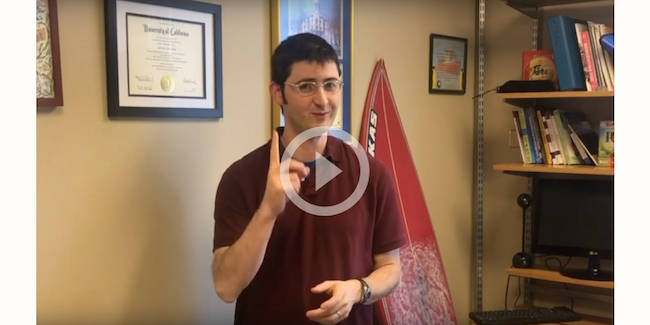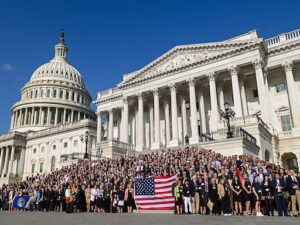State of the bill: Where does the Energy Innovation Act stand?
By Flannery Winchester
It’s been just over two months since the Energy Innovation and Carbon Dividend Act was introduced into this Congress. On that day, CCL volunteers hit the ground running and haven’t stopped. They’ve been calling their members of Congress, giving presentations and conducting outreach in their communities, and much more, all working to build support for this bill and help it move through Congress.
So, where does the bill stand? Has all of that work made the difference we hoped? What happens next? I spoke with Dr. Danny Richter, CCL’s Vice President of Government Affairs, to find out. He shared some of his thoughts in this video recorded at the beginning of April, and we went even deeper in the interview below.
A steady stream of cosponsors
When the Energy Innovation Act was introduced in late January, lead sponsor Rep. Ted Deutch had six original cosponsors with him. Since then, 22 more cosponsors have signed on, for a total of 29 members on the bill. (By the time you read this, that number could be even higher—it’s growing all the time!)
How does that cosponsor number compare to other bills? “Most of them don’t add any,” Danny says. “We just recently added five in one week—that’s amazing. We feel really good that this is able to gather support.”
“When you look at the list of Democratic sponsors, it is regionally diverse, demographically diverse, and that’s drawing more people in,” Danny explains. “Ideologically, you have moderate Democrats and you have liberal Democrats, so we are gathering a large, diverse swath of the Democratic party.”

Rep. Francis Rooney (R-FL)
As far as Republican support, the bill currently has Rep. Francis Rooney (R-FL) as an original cosponsor. Danny says, “We are very, very confident that we’re going to add more Republicans.” Why? Well, we already know that CCL’s process of constituent engagement works to move members of Congress forward—we’ve seen that with the steady stream of cosponsors since introduction, and we saw it work in spades for the Climate Solutions Caucus. It’s worth remembering, both its existence and its inclusion of more Republicans than the Freedom Caucus were supposed to have been impossible.
Plus, the political winds are now more favorable for Republicans to come on board. Danny explains that elections are never very far away for members of the House, and many Republicans have an eye on their upcoming general elections, even more so than their primaries. Presidential election years tend to favor Democrats showing up at the polls, so Republicans are motivated to find bridge issues and stay competitive in 2020. “Based on this, and on conversations we’ve had, it’s looking really good for getting more Republicans on this bill before the end of the year,” Danny says.
Cosponsors on the right committees
While the numbers are encouraging, it’s not just a numbers game. The Energy Innovation Act’s cosponsors also sit on some important committees relevant to the bill. When the bill was introduced, it was referred to three committees: the House Ways and Means Committee, the House Energy and Commerce Committee, and the House Foreign Affairs Committee. These are called the “committees of jurisdiction.” Of the bill’s 29 current cosponsors, 12 of them sit on those committees of jurisdiction.
“That’s super important,” Danny says. “Before the bill ever comes to the floor of the House, you need champions on those committees.” That’s because someone needs to encourage the committee chairmen to schedule the bill for a vote within their committees. Danny emphasizes, “If you don’t have that champion, it’s just not going to move forward.”
So this bill has not just one champion, but 12, on the appropriate committees. To name just a few: lead sponsor Rep. Ted Deutch and Rep. Francis Rooney sit on Foreign Affairs together. Rep. Judy Chu is a member of Ways and Means. Rep. Anna Eshoo and Rep. Scott Peters are both on Energy and Commerce. And that’s just from the original cosponsors!
Support from major institutions
When it comes to support for the Energy Innovation Act, Danny says, “We’ve got a trifecta: other environmental organizations, business, and faith-based groups who are all on record as supporting this bill.” And these aren’t small groups, either—we’re talking major institutions.
Danny rattles them off: “The most profitable companies in the world—one of their trade groups.” That’s the Silicon Valley Leadership Group, which he explains more in the video above. “One of the biggest religions in the world, with over 1 billion adherents, has a positive statement on this.” That’s the Catholic Church. “You’ve got the Natural Resources Defense Council, Environmental Defense Fund, World Resources Institute, Trout Unlimited.” All of these groups have put out positive statements about the Energy Innovation Act, and Danny says, “Those are the kinds of people Congress listens to.”
Not only that, but cities and counties are continually stepping up to pass resolutions in support of this bill, such as the Tompkins County Legislature in Ithaca, New York, and the city of South Miami, Florida. Just a couple of weeks ago, the city of Chicago, Illinois passed a resolution endorsing carbon fee and dividend, which is the structure of this bill.
Media coverage
Surely all this positive progress is worth some media coverage, right? Yes! The bill’s original introduction was covered by The Hill, Politico, NPR’s On Point, and more. It’s garnered more than a dozen editorial endorsements from local newspapers across the country. It’s even been discussed on MSNBC, in an interview with then-Rep. John Delaney, and on Fox News, in an interview with CCL’s own Mark Reynolds.
Of course, it would be great to see the Energy Innovation Act mentioned in every piece of climate news that’s written or produced. But actually, that’s not a requirement for something to move through Congress. “The level of media attention doesn’t affect how we make our case and how we influence the very people we need to influence,” Danny explains.
“We’re making progress where we need to make progress,” he says. “Our audience is Congress, and there, we are making clear, undeniable, recorded progress. It’s very encouraging.”
Danny does envision a point when the story will really break through in the national media. “Once we get a bipartisan bill in the Senate as well, I think you’ll see the media pick way up.” In the meantime, volunteers nationwide are continuing the crucial work that brought us to this point in the first place: activating the levers of political will that move Congress forward.
What happens next?
Now, the bill could progress through “regular order” over a long period of time, or potentially, it could move fast.
“Regular order is the Schoolhouse Rock version of how Congress works,” Danny explains, and it’s the process most bills go through. “A bill is submitted. It’s considered in committee, and there are hearings in the committee. It’s voted out of committee and considered on the floor. It’s voted on on the floor. Then it goes to the other chamber, same process. Both bills, if there are any differences, need to be reconciled in conference committee. Then when that’s done, it goes to the president’s desk.” There, the president could sign it, and it becomes law. Or the president could not sign it, in which case it goes back to Congress, who could vote to override the president’s veto with a ⅔ majority.
“But as the tax reform bill showed, regular order is optional. You don’t necessarily need to have this long process—it can move very quickly,” Danny says. That bill was introduced on November 2, 2017 and signed into law December 22, 2017, less than two months later. “So we need to prepare ourselves for regular order, but we also need to prepare ourselves for a lightning strike.”
How do we do that? To prepare for either path forward, Danny says, “The next step is to get more cosponsors.” At the 2019 Citizens’ Climate International Conference and Lobby Day this June, CCL volunteers will, for the first time, be able to walk onto Capitol Hill in support of a live bill. Every lobby team will ask their member of Congress to sign on as a cosponsor, and attendees who aren’t lobbying will share testimonials and a public art display to get the message across to Congress in a big, public way.
“I am really excited to see what our volunteers can do, especially with such huge statements of support from other environmental groups, from businesses, from the faith community,” Danny says. “It’s going to be fun.”







